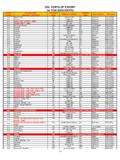Transcription of Introduction to Complex Numbers in Physics/Engineering
1 Introduction to Complex Numbers in physics /EngineeringReference: Mary L. Boas,Mathematical Methods in the Physical SciencesChapter 2 & 14 George Arfken,Mathematical Methods for PhysicistsChapter 6 The real Numbers (denotedR) are incomplete (not closed) in the sense that standard op-erations applied to some real Numbers do not yield a real number result ( , square root: 1). It is surprisingly easy to enlarge the set of real numbersproducing a set of numbersthatisclosed under standard operations: one simply needs to include 1 (and linearcombinations of it).
2 This enlarged field of Numbers , called thecomplex Numbers (denotedC), consists of Numbers of the form:z=a+b 1 whereaandbare real Numbers . Thereare lots of notations for theses Numbers . In mathematics, 1 is calledi(soz=a+bi),whereas in electrical engineeringiis frequently used for current, so 1 is calledj(soz=a+bj). InMathematicacomplex Numbers are constructed usingIfori. Since com-plex Numbers require two real Numbers to specify them they can also be represented as anordered pair:z= (a, b). In any caseais called the real part ofz:a= Re(z) andbiscalled the imaginary part ofz:b= Im(z).
3 Note that the imaginary part of any complexnumber is real and the imaginary part of any real number is zero. Finally there is a polarnotation which reports the radius ( absolute value ormagnitude) and angle ( or argument) of the Complex number in the form:r . The polar notation canbe converted to an algebraic expression because of a surprising relationship between theexponential function and the trigonometric functions:ej = cos +jsin (1)Thus there is a simple formula for the Complex numberz1in terms of its magnitude andangle:|z1| a2+b2=r(2)a=rcos =|z1|cos (3)b=rsin =|z1|sin (4)z1=a+bj=|z1|(cos +jsin ) =|z1|ej (5)For example, we have the following notations for the complexnumber 1 +i.
4 1 +i= 1 +j= 1 +I= (1,1) = 2 45 = 2ej /4(6)Note that Equation 1 can be used to express the usual trigonometric functions in terms ofcomplex exponentials:cos = Re(ej ) =ej +e j 2sin = Im(ej ) =ej e j 2j(7)Since Complex Numbers are closed under the standard operations, we can define things whichpreviously made no sense: log( 1), arccos(2), ( 1) , sin(i), .. The Complex Numbers arelarge enough to define every function value you might want. Note that addition, subtraction,ReImz1 b aReIm barz1 a2+b2 = rFigure 1: Complex Numbers can be displayed on the Complex plane.
5 A Complex numberz1=a+bimay be displayed as an ordered pair: (a, b), with the real axis the usualx-axis and the imaginary axis the usualy-axis. Complex Numbers are also often displayedas vectors pointing from the origin to (a, b). The angle can be found from the usualtrigonometric functions;|z1|=ris the length of the , and division of Complex Numbers proceeds as usual, just using the symbolfor 1 (let s usej):z1=a+bjz2=c+dj(8)z1+z2= (a+bj) + (c+dj) = (a+c) + (b+d)jz1 z2= (a+bj) (c+dj) = (a c) + (b d)jz1 z2= (a+bj) (c+dj) =ac+adj+bcj+bdj2= (ac bd) + (ad+bc)j1z1=1a+bj=1a+bj a bja bj=a bja2+b2=aa2+b2+ ba2+b2jNote in calculating 1/z1we made use of the Complex numbera bj.
6 A bjis called thecomplex conjugateofz1and it is denoted byz 1or sometimesz1. See thatzz =|z| that, in terms of the ordered pair representation ofC, Complex number addition andsubtraction looks just like component-by-component vector addition:(a, b) + (c, d) = (a+b, c+d)(9)ReImz1z1*ReImz1+z2z1z2 Figure 2: The Complex conjugate is obtained by reflecting thevector in the real number addition works just like vector there is a tendency to denote Complex Numbers as vectorsrather than points in thecomplex of OscillationWhile the closure property of the Complex Numbers is dear to the hearts of mathematicians,the main use of Complex Numbers in science is to represent sinusoidally varying quantitiesin a simple way allowing them to be combined with relative ease.
7 (Remember that thesuperposition of sinusoidal quantities is itself sinusoidal, but with a new amplitude andphase.) For example, in a seriesRCcircuit the voltage across the resistor might be givenbyVR(t) =Acos twhereas the voltage across the capacitor might be given byVC(t) =Bsin t, and the voltage across the combination (according to Kirchhoff) is the sum:VR(t) +VC(t) =Acos t+Bsin twhere:A, B R= A2+B2(A A2+B2cos t+B A2+B2sin t)= A2+B2(cos cos t+ sin sin t)where: cos =A A2+B2= A2+B2cos( t )Yuck! That s a lot of work just to add two sinusoidal functions; we seek a simpler method(which might not seem overly simple at first glance).
8 Note thatVRcan be written asRe(Aej t) andVCcan be written as Re( jBej t) so:VR(t) +VC(t) = Re((A jB)ej t)(10)Now using the polar form of the Complex numberA jB:A jB= A2+B2e j where: tan =B/A(11)we have:VR(t) +VC(t) = Re((A jB)ej t)= Re( A2+B2e j ej t)= A2+B2Re(ej( t ))= A2+B2cos( t )If we have more sinusoidal waves to add up, the problem is not much more difficult. Considerthe case of adding four waves, which for ease of notation we assume have unit amplitudeand constant phase difference ( ). [I m also going to switch to 1 =i; you should getused to both notations.]
9 ]f(t) = cos( t) + cos( t+ ) + cos( t+ 2 ) + cos( t+ 3 )(12)We can write this as the real part of a Complex expression:f(t) = Re[(1 +ei +ei2 +ei3 )ei t](13)1234-3-2-1123 Figure 3: Consider the problem of adding four sinusoidal functions with the same frequencyand amplitude, but with different offsets (see left). The result (right) is a sinusoidal functionwith the same frequency we seek to easily determine the resulting amplitude and ll use some tricks below to add these four Complex Numbers , but for now the main pointis that they add to some Complex number which can be expressedin polar form:(1 +ei +ei2 +ei3 )=A ei (14)sof(t) = Re[A ei( t+ )]=Acos( t+ )(15)Thus adding sinusoidal waves is as simple as adding the corresponding ( Complex ) for the trick that applies to this particular problem.
10 Recall the formula for the sum ofthe geometric series:1 +r+r2+ +rN 1=1 rN1 r(16)(The proof of this result is easy: just multiply both sides by(1 r), and notice that therhs terms telescope down to 1 rN.) Here:r=ei (17)So the sum is:A ei =1 ei4 1 ei =ei2 ei /2ei2 e i2 ei /2 e i /2=ei3 /2sin(2 )sin( /2)(18)ReIm2 3 Figure 4: Finding the sum of four cosines amounts to adding four Complex amplitudes:(1 +ei +ei2 +ei3 )123451015 Figure 5:A2is plotted as a function of . Note that if = 0,2 ,4 , .., the four wavesare in phase so the amplitude is 4 (soA2= 16).










